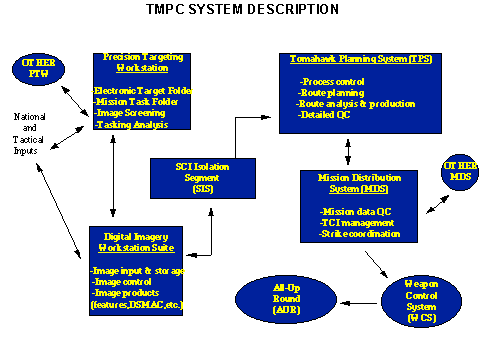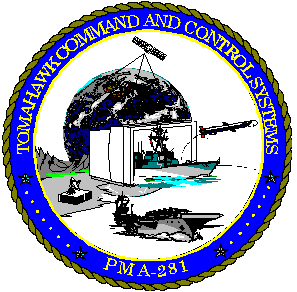



 Tomahawk cruise missiles, carried by submarines and surface ships, enable seaborne forces to launch attacks against surface and land targets from distant ranges, in all types of weather. The Navy has taken steps in recent years both to increase the effectiveness of the Tomahawk system and to strengthen mission planning capabilities. Improvements in the
former area were demonstrated during the September 1995 missile strikes against targets in Bosnia and Herzegovina, with Tomahawks destroying or damaging all of their intended targets with no collateral damage. Programmed enhancements include the Tomahawk Afloat Planning System and the Advanced Tomahawk Weapon Control System, scheduled for introduction within the next several years. These upgrades will allow forces at sea to plan and modify land-attack missions more rapidly than is currently possible.
The MK 37 TOMAHAWK Weapon System (TWS) supports the Navy mission of sea control and projection of power with a long range, low altitude attack of land targets with a conventional warhead land strike capability. The TWS provides the capability to attack inland targets in areas where the United States may or may not have sea or air control. The TWS is composed of the following components: All-Up-Round (AUR), Vertical Launch System (VLS), launch platform, Theater Mission Planning Center (TMPC), and the TOMAHAWK Weapon Control System (TWCS).
The Advanced Tomahawk Weapon Control System is a significant upgrade to the current system, and will reduce overall reaction time, enhance training capabilities at all levels, reduce operator workload, and improve Tomahawk strike effectiveness. The ATWCS improvements will include hardware (including the use of the Navy’s standard tactical computers), software, and firmware modifications that will introduce new capabilities, such as contingency-strike operations planning, embedded training at all levels, and a simplified man-machine interface. ATWCS incorporates an open architecture to provide for future growth, eliminates stand-alone Tomahawk desk-top computers, and enhances command and control interoperability.
The APS are installed on aircraft carriers and in portable vans on other designated afloat command platforms. Missions are planned by operational planners at one of the Cruise Missile Support Activities or at one of the Afloat Planning System Detachments. The mission is then delivered to the firing unit via operational communications systems. The cognizant staff then plan a strike, and task the firing unit with the TLAM launch. The fleet unit then complies with the tasking, using the fire control system to prepare the missile for launch.
The Tomahawk Afloat Planning System (TAPS) takes the mission planning afloat and allows the battle group/battle force commanders rapidly to plan or modify Tomahawk Land- Attack Missile (TLAM) missions while at sea. This software is a portable version of the two theater mission planning centers. TAPS provide Theater Mission Planning Center (TMPC) capability with the exception of Data Transport Device initialization to naval commanders afloat.
The TMPC are installed at Cruise Missile Support Activities (CMSA) Atlantic and Pacific. The TMPC is made up of four primary segments: the Digital Imagery Workstation Suite (DIWS); TLAM Planning System; Mission Distribution System; Precision Targeting Workstation. The DIWS receives hardcopy and digital imagery, digitizes the
hardcopy imagery, evaluates potential DSMAC map areas, and creates imagery products. The PTW provides image screening, tasking analysis, and mission task folders. The TPS generates and displays TLAM routes, assembles mission data, and performs
quality control checks. MDS disseminates the mission information to the launch platforms and afloat staffs. The TMPC with software version 2.3, the system currently in use, was tested in February 1995. It included the ability to plan Precision Strike
TOMAHAWK (PST) missions, which reduce the risk of collateral damage while maintaining effectiveness during TOMAHAWK strikes. PST consists of software improvements to conventional TLAM missiles, mission planning and command and control systems, and fire control systems. TMPC with version 2.4 was tested in November 1996, and was released in October 1997.
Tomahawk cruise missiles, carried by submarines and surface ships, enable seaborne forces to launch attacks against surface and land targets from distant ranges, in all types of weather. The Navy has taken steps in recent years both to increase the effectiveness of the Tomahawk system and to strengthen mission planning capabilities. Improvements in the
former area were demonstrated during the September 1995 missile strikes against targets in Bosnia and Herzegovina, with Tomahawks destroying or damaging all of their intended targets with no collateral damage. Programmed enhancements include the Tomahawk Afloat Planning System and the Advanced Tomahawk Weapon Control System, scheduled for introduction within the next several years. These upgrades will allow forces at sea to plan and modify land-attack missions more rapidly than is currently possible.
The MK 37 TOMAHAWK Weapon System (TWS) supports the Navy mission of sea control and projection of power with a long range, low altitude attack of land targets with a conventional warhead land strike capability. The TWS provides the capability to attack inland targets in areas where the United States may or may not have sea or air control. The TWS is composed of the following components: All-Up-Round (AUR), Vertical Launch System (VLS), launch platform, Theater Mission Planning Center (TMPC), and the TOMAHAWK Weapon Control System (TWCS).
The Advanced Tomahawk Weapon Control System is a significant upgrade to the current system, and will reduce overall reaction time, enhance training capabilities at all levels, reduce operator workload, and improve Tomahawk strike effectiveness. The ATWCS improvements will include hardware (including the use of the Navy’s standard tactical computers), software, and firmware modifications that will introduce new capabilities, such as contingency-strike operations planning, embedded training at all levels, and a simplified man-machine interface. ATWCS incorporates an open architecture to provide for future growth, eliminates stand-alone Tomahawk desk-top computers, and enhances command and control interoperability.
The APS are installed on aircraft carriers and in portable vans on other designated afloat command platforms. Missions are planned by operational planners at one of the Cruise Missile Support Activities or at one of the Afloat Planning System Detachments. The mission is then delivered to the firing unit via operational communications systems. The cognizant staff then plan a strike, and task the firing unit with the TLAM launch. The fleet unit then complies with the tasking, using the fire control system to prepare the missile for launch.
The Tomahawk Afloat Planning System (TAPS) takes the mission planning afloat and allows the battle group/battle force commanders rapidly to plan or modify Tomahawk Land- Attack Missile (TLAM) missions while at sea. This software is a portable version of the two theater mission planning centers. TAPS provide Theater Mission Planning Center (TMPC) capability with the exception of Data Transport Device initialization to naval commanders afloat.
The TMPC are installed at Cruise Missile Support Activities (CMSA) Atlantic and Pacific. The TMPC is made up of four primary segments: the Digital Imagery Workstation Suite (DIWS); TLAM Planning System; Mission Distribution System; Precision Targeting Workstation. The DIWS receives hardcopy and digital imagery, digitizes the
hardcopy imagery, evaluates potential DSMAC map areas, and creates imagery products. The PTW provides image screening, tasking analysis, and mission task folders. The TPS generates and displays TLAM routes, assembles mission data, and performs
quality control checks. MDS disseminates the mission information to the launch platforms and afloat staffs. The TMPC with software version 2.3, the system currently in use, was tested in February 1995. It included the ability to plan Precision Strike
TOMAHAWK (PST) missions, which reduce the risk of collateral damage while maintaining effectiveness during TOMAHAWK strikes. PST consists of software improvements to conventional TLAM missiles, mission planning and command and control systems, and fire control systems. TMPC with version 2.4 was tested in November 1996, and was released in October 1997.
The TMPC program tests all aspects of data base input, data base storage, mission route planning, and mission distribution for the TOMAHAWK land attack missile (TLAM). The TMPC provides data base generation, data base processing, preparation and distribution of flight mission data, and command and control information for both nuclear (TLAM/N) and conventional (TLAM/C and D) TOMAHAWK missiles. TLAM flight and route data, including Terrain Contour Matching (TERCOM) maps and Digital Scene Matching Area Correlator (DSMAC) map data are required by the TLAM Operational Flight Program (OFP) for navigation from the initial preplanned waypoint to the target. The TMPC interfaces with the TOMAHAWK Weapon Control System (TWCS) through the integrated Officer-in- Tactical-Command Information Exchange System (OTCIXS)/Tactical Data Information Exchange System-A (TADIXS-A).
APS Navy Program Decision Meeting (NPDM) was held on 31 August 1994, and approval granted to enter Full-Rate Production (FRP Milestone III). APS Operational Evaluation (OPEVAL) conducted in FY 1994. APS entered fleet service in 1996. The APS Maintenance course is designed to teach the knowledge and skills needed to perform required Preventive Maintenance, Trouble-Shooting, Fault Isolation and Corrective Maintenance on the Afloat Planning System and Joint Service Imagery Processing System - Navy hardwares. The course is taught at the Navy and Marine Corps Intelligence Training Center (NMITC), Damneck VA. Training is supported by one suite of Afloat Planning System (APS) and Navy-Tactical Input Segment (N-TIS), tactical training equipment (TTE). Maintenance actions include preventative and corrective maintenance for the alignment, adjustment, removal, repair and replacement of equipment. Fault detection and isolation test include computer diagnostic tests and manual fault isolation of casualties to the lowest replaceable assembly (printed circuit card or mainframe mounted piece part), removal and replacement of interconnecting wiring harnesses. The course covers maintenance procedures for the three APS segments (DIWSA, TPSA and MDS) and the unique Navy - Tactical Input Segment (N-TIS) which supports the JSIPS-N function. Developer/Manufacturer: